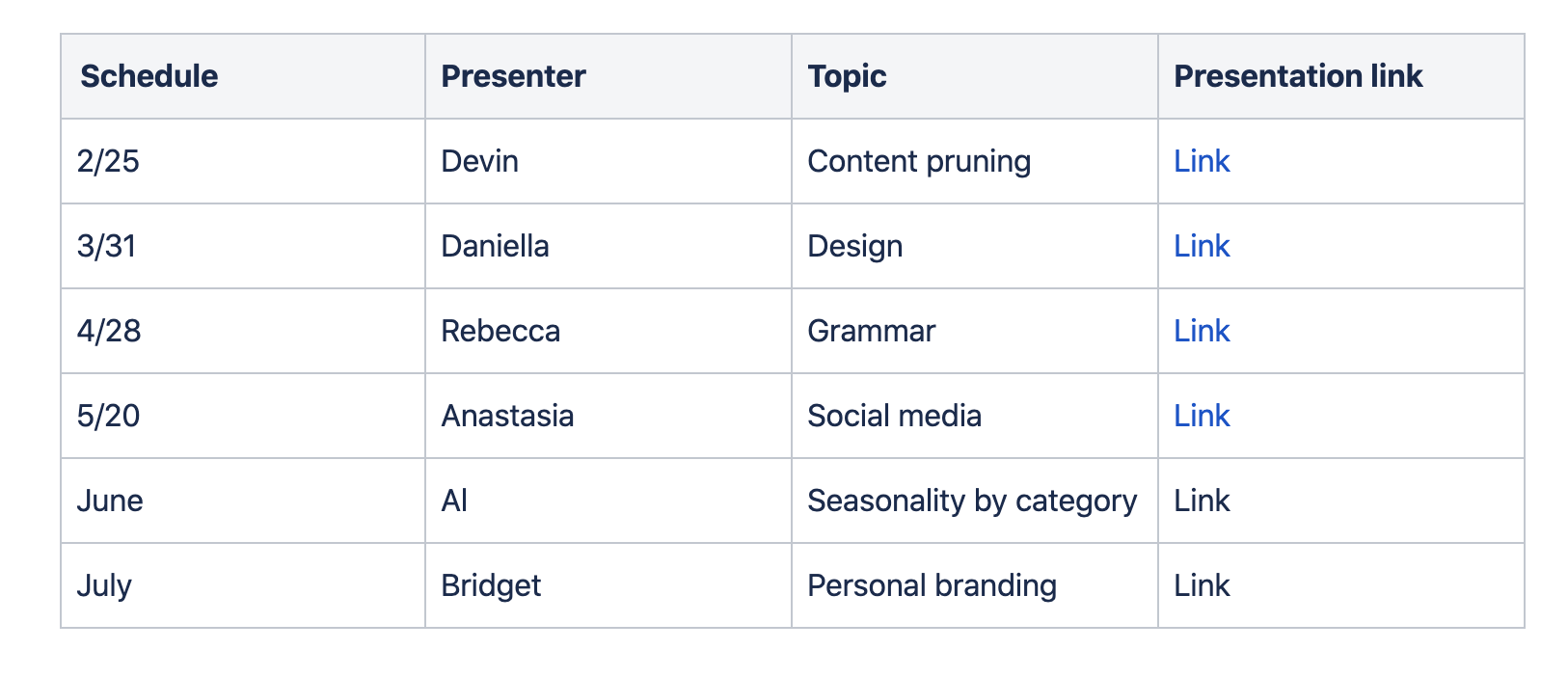They say knowledge is power.
Knowing this, we wanted to create something that allowed our employees to share their areas of expertise with the team. Our team has many moving parts with people that focus on writing quality content and others who are SEO experts, but as we all know, being a well-rounded marketer is crucial in today’s world.
We weren’t alone in thinking that we needed to start sharing across our team. In fact, 85% of employees agree that preserving and sharing unique knowledge in the work place is critical to increasing productivity.
So we tried (and failed) twice to create an effective knowledge sharing process, but the third time was the charm. Read on to discover what we did wrong and what we’re currently doing right.
But first, let’s cover some of the basics for those of you who are just realizing the power of knowledge sharing.
What is knowledge sharing? Knowledge sharing is a collaboration method where teams enable each other to collectively get smarter by offering their expertise, information, and/or skills
Why knowledge sharing is important
Inefficient knowledge sharing costs large businesses $47 million a year. Aside from saving companies money, knowledge sharing also:
- Fills knowledge gaps: If someone is unsure of something but too afraid to ask, a knowledge share can teach them all they need to know.
- Creates experts: Oftentimes people sell themselves short, but if they are pushed to share, they will become the expert in that area to their teammates, which boosts their confidence.
- Nurtures a learning culture: Career development is crucial to employee retention and company growth. When employees know you prioritize their learning, it will create a positive domino effect.
- Provides an internal knowledge base: It’s nearly impossible to learn a skill from scratch, so if someone has a particular skill set, make sure their knowledge is documented in an easily accessible place.
Now for the fun part. You now know why knowledge shares are important, so let’s dive into how we failed in our knowledge sharing efforts twice.
Want to learn more about Knowledge Management Software? Explore Knowledge Management products.
How we failed
We have a team of extremely talented individuals. Everyone has a niche that they’re particularly passionate about and well-versed in, but we didn’t know how to spread that knowledge to others.
We didn’t want to force people to take time out of their busy days to share and listen. But we also didn’t want people to lose out on the benefits of knowledge shares.
So we tried a few things that didn’t end up working out.
Lunch and learns
In theory, lunch and learns are great. And I’m sure some of you reading have had some success with them. We, however, did not.
Lunch and learns are presentations that happen over lunchtime. The idea is that people use their lunch breaks to be productive and learn.
Our lunch and learns were sporadic and done on an as-needed basis. For example, if we were creating a new keyword mapping strategy, calendar invites during lunch on Friday would be sent to the team. Then, the leader of the project would present on their work and ask for questions about the topic.
We thought this idea was great because it was only ‘as needed’ and it didn’t cut into the workday.
We thought wrong.
People wanted knowledge shares to be standardized – not random. They also didn’t like sacrificing their lunchtime for learning. Instead, employees wanted to see that G2 leadership valued knowledge sharing enough to take time out of the actual workday.
Employees stopped attending. Experts stopped sharing. There was a slow fade out, and the lunch and learns simply stopped happening.
Office hours
A couple of months later, employees expressed a desire to share aspects of their niche projects, but we didn’t want a repeat of lunch and learns. So we came up with office hours that would be on Friday afternoons where people could freely discuss ideas with topic experts.
The hope was that the set time and lack of structure within the time would allow employees to talk about what they’ve been working on and brainstorm ways to improve upon their ideas. Fridays afternoons were already less productive than other times, so employees could use it to talk about areas of interest and improvement.
A few of these sessions were successful because people came eager to learn and share. But Friday afternoon is a difficult time to focus, and everyone, including me, shifted focus from sharing work knowledge to sharing what their weekend plans were.
Instead of letting this idea fade out, we actively decided that we needed a newer and better system in place for knowledge sharing. Previously, this task had been on the back burner of many people’s plates, with no established project owner. So I was asked to formalize the process and develop a method that actually worked.
Our recipe for a knowledge sharing system that works
We learned from our previous mistakes and finally created a knowledge sharing process that benefits both the team and the expert(s).
Our third knowledge sharing attempt was dubbed CSO in the Know, CSO standing for “Content, SEO, and Offsite,” a term we use to describe our team, and “in the know” as the goal of the knowledge shares: keeping everyone informed about specific topics. This title formalized our knowledge shares and made them unique to our team.
There are three components of our knowledge shares that help make the system a success: consistency, relevancy, and transparency.
Consistency
First, we presented the concept in our weekly team meeting. Then, we asked team members to volunteer to share.
The same day that this concept was rolled out, we filled the first six months of knowledge shares with willing and enthusiastic volunteers. I was shocked! To be honest, I thought we’d get crickets from the team and was worried this too would fall flat.
But with the consistency of presentation style, people were more willing to step up and share.
We created a document and a template explaining expectations, making it easy for the volunteer to input their knowledge without extra work. It also allows our team to understand what to expect in each knowledge share.

Additionally, CSO in the Know is scheduled at the beginning of the week at the end of every month for 30 mins. So there are no surprises, and it’s a small-time commitment. Plus, presenters are forced to consolidate and share only the most important information.
The week before the knowledge share, presenters have a meeting with me to go through a mock presentation. This way, I can give formatting suggestions, presentation feedback, and tips to engage with the audience. Our team does not have a lot of formal presentation opportunities, so these knowledge shares help them to improve upon that crucial skill.
Our first knowledge share was on content pruning, followed by presentations on grammar, graphic design, and social media best practices. We had 100% attendance at all of these presentations.
Relevancy
People will stop participating if topics are not interesting. Simple as that. Ensure that you aren’t just trying to fill the knowledge share time. Instead, really focus on what would bring value to the team.
Don’t be afraid to push someone further on their topic pitch. If there’s something timely occurring, figure out a way to integrate that into the next knowledge share. No one wants to be part of something boring and stale.
If you know someone on your team has been working on something innovative and engaging, ask them if they’d be willing to present. It’s OK to be proactive instead of waiting for people to come to you.
The only way a knowledge share can last is if it’s relevant to employees. So be sure to emphasize the importance of relevancy when telling your employees about the knowledge sharing process.
Transparency
After the presentation ends, the work doesn’t stop. Create a space using knowledge management software for employees to access the slides after the presentation. It’s easy to do, but often forgotten until it’s too late.
That way, if they need a refresher, they don’t have to wait on someone else for the information. They can easily click the link to re-learn pertinent information.
Here’s the extremely simple, yet effective chart we use within our knowledge management platform:

Another reason documenting knowledge shares in one place is important is because people throughout the company can access the information. So if someone is looking to learn about what your particular team is doing and needs to add that skill set to their own team, they can teach themselves using the slides linked in the knowledge management tool.
The last benefit of having transparent documentation of the process and knowledge shared is for employees that are absent during the presentation or people that are new to the team.
The more you know, the better
You’re one step closer to creating a knowledge sharing system that works. Don’t be afraid to fail a couple of times first, but always keep consistency, relevancy, and transparency top of mind when creating your very own strategy.
There are other ways to enhance productivity and performance at work. One way is by building a more collaborative culture at work.

Deirdre O'Donoghue
Deirdre O’Donoghue is a Content Manager at Nature's Fynd and a former Content Manager at G2. In her free time, you can find Deirdre fostering puppies or exploring the Chicago foodie scene. (she/her/hers)
